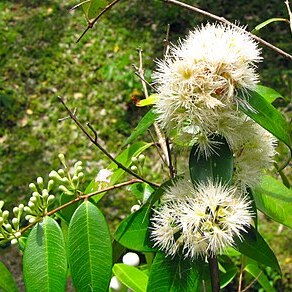Trees, to 12 m tall. Branchlets yellowish brown when dry, terete; old branches grayish brown. Petiole 4-7 mm; leaf blade thinly long ovate to ovate-oblong, 8-10.5 × 3-4.5 cm, leathery, abaxially yellowish brown when dry, adaxially olive green and glossy when dry, secondary veins numerous, 2-3 mm apart, at an angle of 80°-85° from midvein, abaxially slightly raised, and adaxially conspicuous, intramarginal veins ca. 1 mm from margin, base rounded to obtuse, apex acuminate to caudate-acuminate and with a 1-1.5 cm cusp. Inflorescences terminal or subterminal, paniculate cymes, 2-4 cm; peduncle slender. Flower buds clavate, ca. 7 mm. Hypanthium 5-6 mm. Calyx lobes 4 or 5, reniform rounded, ca. 1 mm. Petals pale yellow, distinct, obovate, 3-4 mm. Stamens longer than petals. Fruit white, globose, 5-6 × ca. 7 mm. Fl. Apr-Jul, fr. Nov.
More
A small tree. It grows 7-12 m tall. The leaves are narrowly oval. They are 5-11 cm long by 3-5 cm wide. They are leathery. The flowers are in groups near the ends of branches. The petals are pale yellow. The fruit are round and white. They are 5-6 mm wide. There is one seed.


